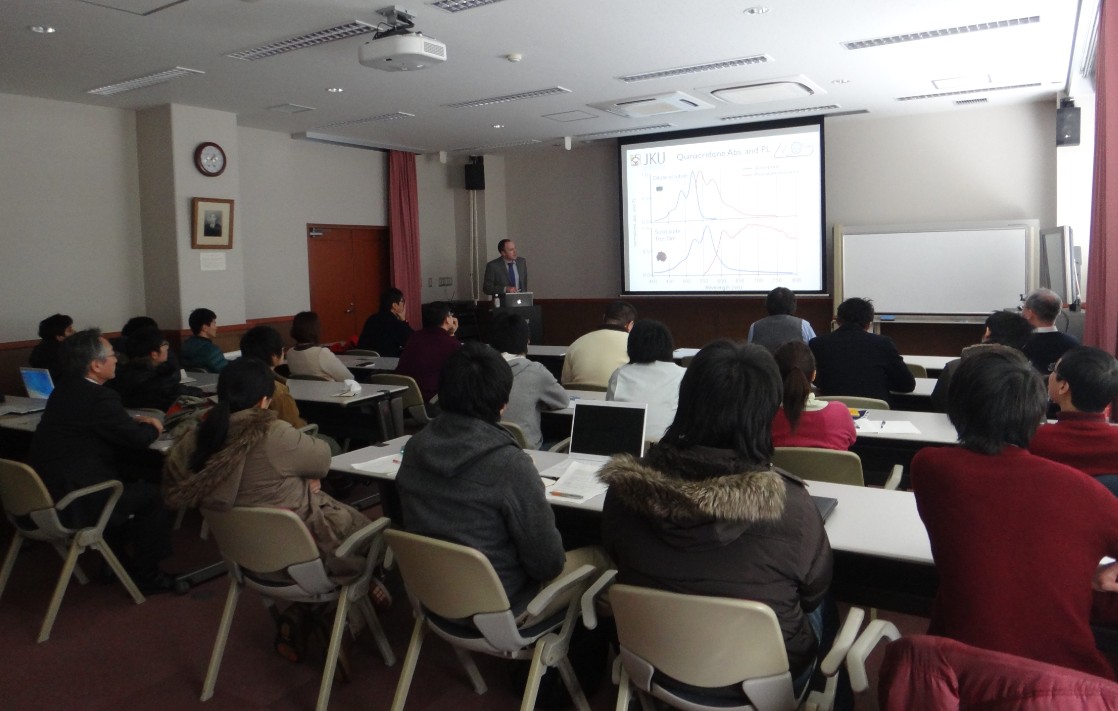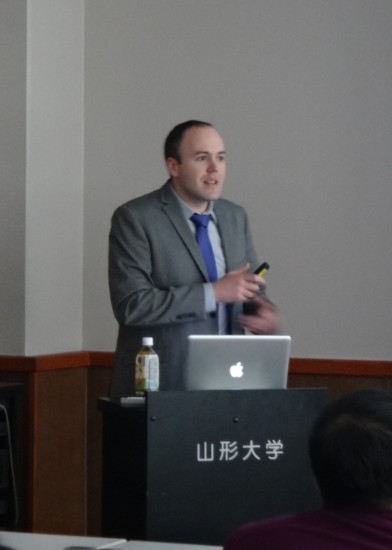【開催終了】 第54回 有機エレクトロニクス研究センター講演会について(2月22日)
2013年02月27日 掲載
2月22日午後1時より、国際事業化研究センター3階セミナーホール(秦ホール)にて、第54回 有機エレクトロニクス研究センター講演会が開催されました。
今回は、オーストリアからDr. Matthew Whiteをお招きし、Current research topics from LIOS: “Hydrogen bonded organic semiconductors” and “Ultrathin organic electronics"という題で講演をして頂きました。
30名を超える研究者、学生が参加し、盛況のうちに終了しました。

当日の会場の様子 | 
Dr. Matthew White,
Johannes Kepler University of Linz |
【開催終了】 第54回 有機エレクトロニクス研究センター講演会について(2月22日)
2013年02月15日 掲載
日時 | 2月22日(金) 午後1時00分~午後2時30分 |
会場 | 国際事業化研究センター3階セミナーホール(秦ホール) |
講師 | Dr. Matthew White, Johannes Kepler University of Linz |
演題 | Current research topics from LIOS: “Hydrogen bonded organic semiconductors” and “Ultrathin organic electronics" |
The first portion of this lecture will challenge some conventional wisdom regarding the design of both organic semiconductors and organic opto-electronic devices. Our recent work shows how small molecules that lack the high degree of intra-molecular conjugation typically associated with “good” organic semiconductors can give surprisingly good carrier transport and air stability. The π-overlap between these molecules is enhanced by the forced molecular orientation associated with hydrogen bonds. Thus, transport is anisotropic, but gives very reasonable mobility. The good molecular packing has strongly affects both the absorption and luminescence of the molecules. We further show, that hydrogen bonded organic semiconductors can be used in single-material solar cells, producing over 1 mA/cm2 in the absence of a heterojunction.
Changing topics, I will show our recent developments in the field of ultrathin organic electronics. Organic solar cells and LEDs are inherently thin, and it is frequently claimed that low-weight and flexibility are natural advantages of the technology. However, most substrate materials are much thicker and most flexible foils are 100 µm, whereas the active device is only 200 nm thick. Therefore, the mechanical properties of weight and flexibility are entirely determined by the substrate. We show a method for processing organic PV and LEDs directly onto foil substrates that are less than 2 µm thick. This allows continuous operation of devices under extreme deformation. We can crumple the films, bend them to radius of under 5 µm, and even stick them to elastomeric tape to form stretchable PLEDs and OPV cells. Their weight becomes negligible (only 4 g/m2), resulting in ultrathin OPV with the highest specific weight (W/kg) of any photovoltaic technology.
なお、本講演会の後に学生主体のショートプレゼンテーションも同会場にて行われる予定です。















